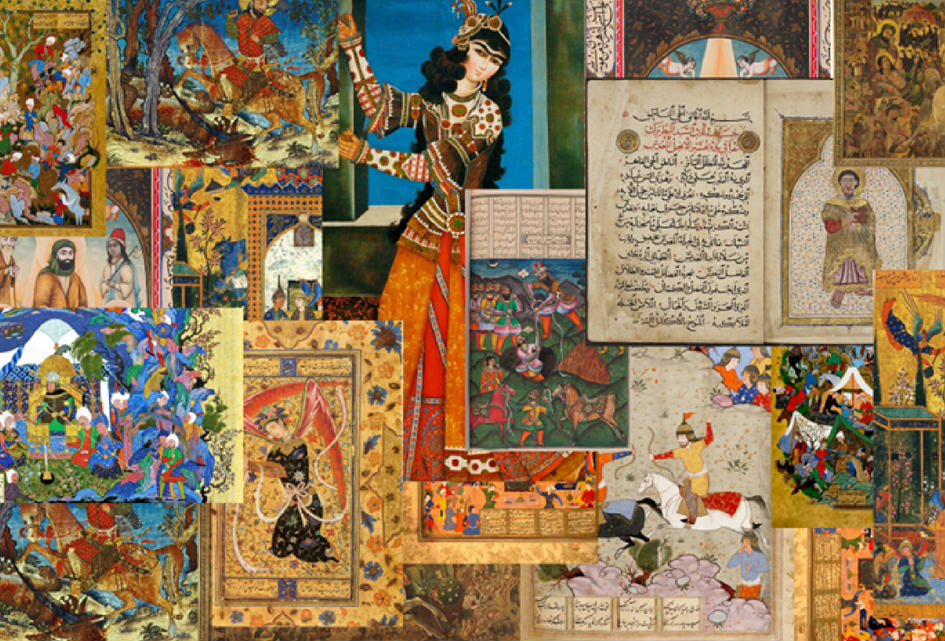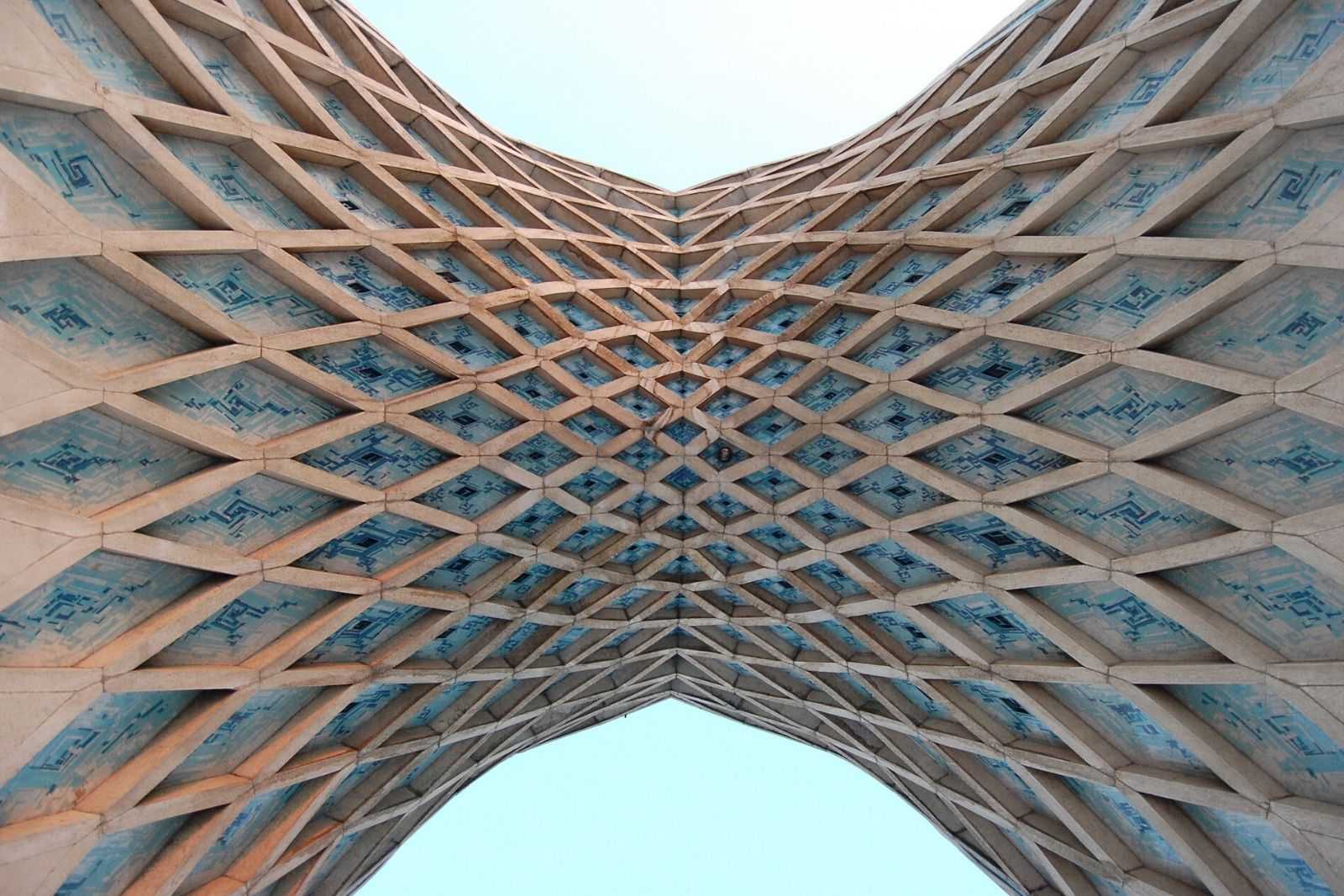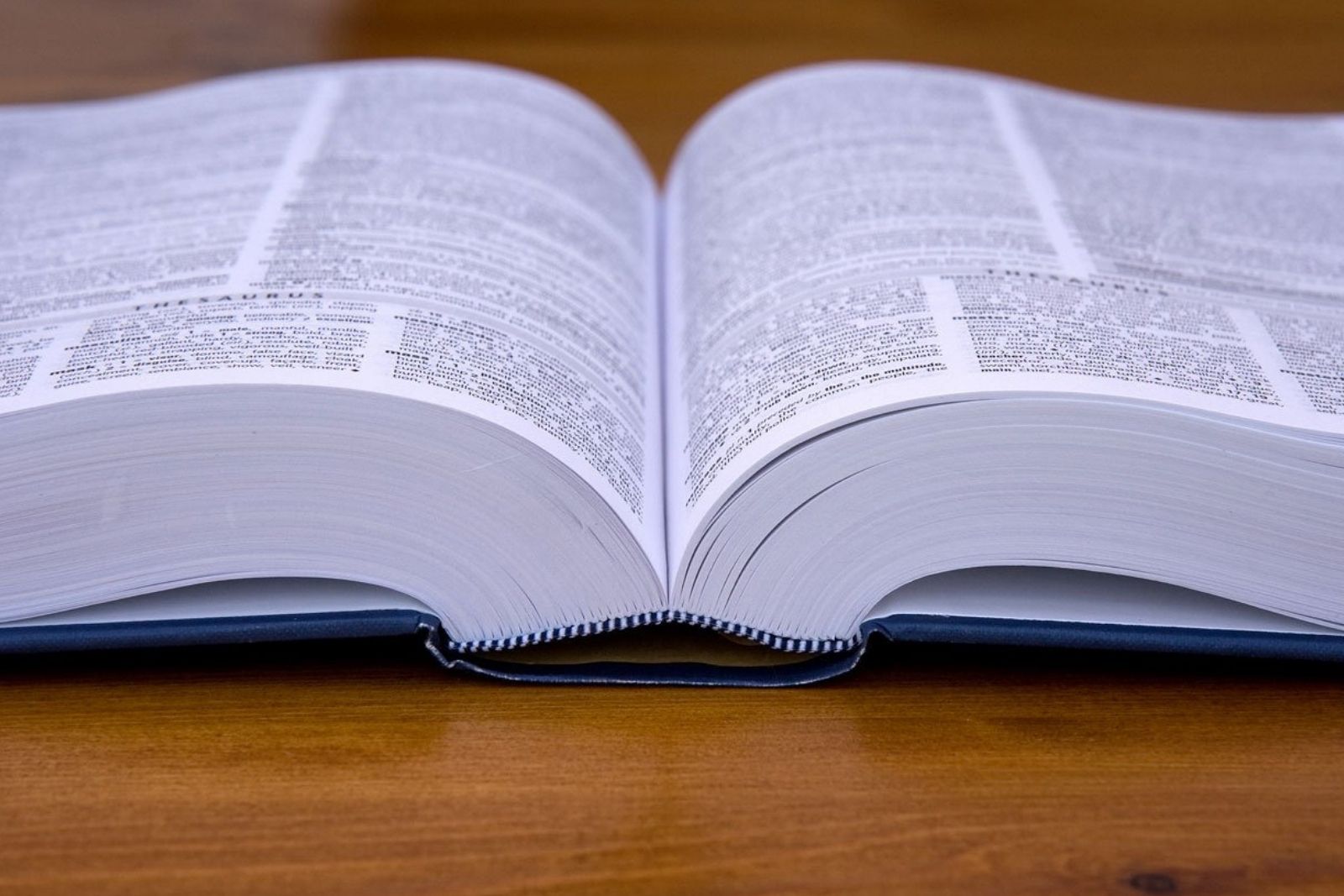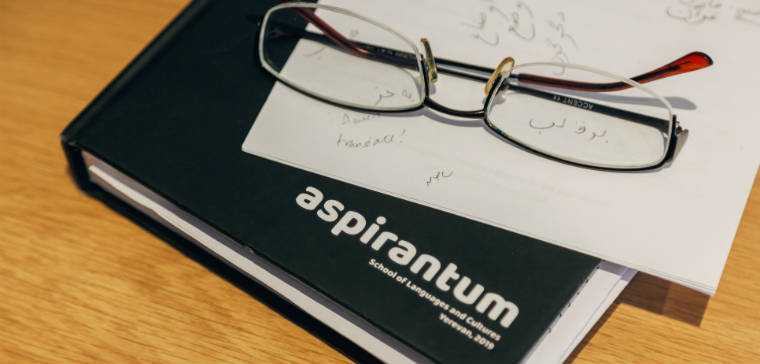Many languages today use scripts that are based upon an alphabetic writing system. We all know what an alphabet looks like, but how many know where it came from?
The most commonly accepted view is that the first alphabetic script was developed on the basis of the Egyptian hieroglyphic script, and passed on to the Phoenicians, Greeks, Arameans, etc.
Compared to the hieroglyphic or cuneiform scripts, it was more user-friendly and easy to use. This is why the speakers of many languages today prefer to use an alphabetic script.
The speakers of Persian use an alphabet that is based on the Arabic script. The difference between the Persian and Arabic alphabets is the addition of a couple of letters in the former. Otherwise, they are identical. Interestingly enough Persian has also been written in Armenian script. The article by Dr. Kirakosyan presents the preserved Persian texts in Armenian script.
But why do the speakers of Persian use the Arabic script, and how long has it been in use? What does that alphabet look like?
To these and other questions I will try to answer in this article. I hope you will find it useful.
General Characteristics of the Farsi alphabet
The Persian alphabet has 32 letters. This is what it looks like:
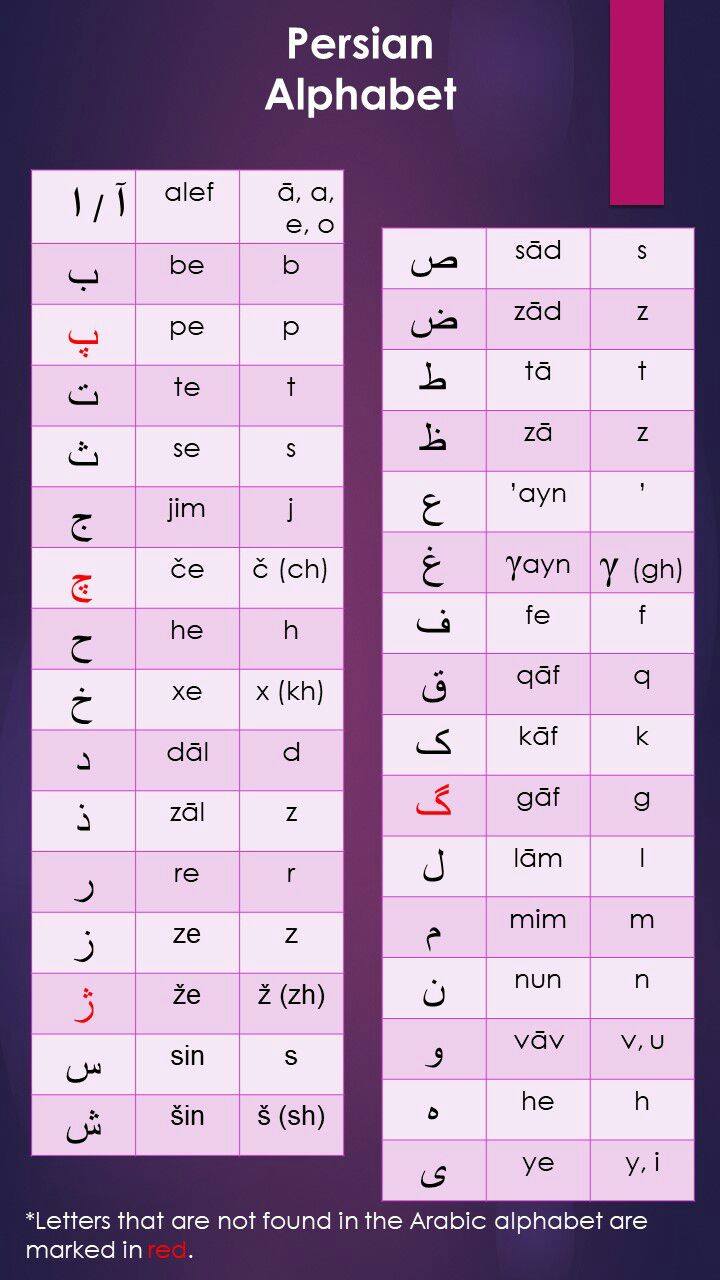
The Persian alphabet chart below is copied from https://www.persianlanguageonline.com/alphabet
| Sound in English | Name of letter | End of word or attached to previous letter | Middle, or inbetween two letters | Initial or followed by another letter | Unconnected, standing alone |
| 'ā' and initial vowels 'a', 'e' and 'o' | alef* | ــا | ــا | ا | آ or ا |
| b | be | ــب | ــبــ | بــ | ب |
| p | pe | ــپ | ــپــ | پــ | پ |
| t | te | ــت | ــتــ | تــ | ت |
| s | se | ــث | ـثــ | ثــ | ث |
| j | jim | ــج | ـجــ | جــ | ج |
| ch | che | ــچ | ــچــ | چــ | چ |
| h | he | ــح | ــحــ | حــ | ح |
| kh | khe | ــخ | ــخــ | خــ | خ |
| d | dāl* | ــد | ــد | د | د |
| z | zāl* | ــذ | ــذ | ذ | ذ |
| r | re* | ــر | ــر | ر | ر |
| z | ze* | ــز | ــز | ز | ز |
| zh | zhe* | ــژ | ــژ | ژ | ژ |
| s | sin | ــس | ــســ | ســ | س |
| sh | shin | ــش | ــشــ | شــ | ش |
| s | sād | ــص | ــصــ | صــ | ص |
| z | zād | ــض | ــضــ | ضــ | ض |
| t | tā | ــط | ــطــ | طــ | ط |
| z | zā | ــظ | ــظــ | ظــ | ظ |
| ‘ (a) | ‘ain | ــع | ــعــ | عــ | ع |
| gh | ghain | ــغ | ــغــ | غــ | غ |
| f | fe | ــف | ــفــ | فــ | ف |
| q | qāf | ــق | ــقــ | قــ | ق |
| k | kāf | ــک | ــکــ | کــ | ک |
| g | gāf | ــگ | ــگــ | گــ | گ |
| l | lām | ــل | ــلــ | لــ | ل |
| m | mim | ــم | ــمــ | مــ | م |
| n | nun | ــن | ــنــ | نــ | ن |
| v, w, u & o | vāv* | ــو | ــو | و | و |
| h | he | ــه | ــهــ | هــ | ه |
| y | ye | ــی | ــیــ | یــ | ی |
There are a couple of basic things that you need to know about the Persian script.
First, unlike the Latin script, it is written from right to left, which may seem a little bit strange to you, but you can always comfort yourself with the knowledge that there are scripts even stranger (like the Luwian script, which is written from left to right, and then from right to left, interchangeably).
Secondly, Persian is a cursive script. This means that its letters, when you write them, tend to be attached. At first glance, it may seem to be somewhat difficult to grasp the principle, but the point is that the letter-forms that you see in the alphabet above change their forms when put into a line with other letters.
So, for example, take the letter ج (j). It may form combinations like these: جا ,نجد ,گنج. The first word you see here consists of three letters: گ ,ن ,ج. You may identify the letter ج by following the dot below. The shape of the letter changes in accordance with its position at the beginning, middle, or end of the word.
The third thing to know about the Persian alphabet is that it does not have capital letters. This means that both proper names and ordinary nouns are written with the same letter-forms.
The fourth important thing and this is a major one, is that the three short vowels a, e, o, are not written. This is why, if you try to read Persian words letter by letter, you would see something like this: gnj, dl, grg. While these words are pronounced like ganj, del, and gorg. In textbooks for beginners, you will have these sounds indicated by special signs placed above the letters (see the list of the special signs below).
The Otiose Letters in Persian
The Arabic and Persian languages belong to different language families and are quite different from each other both grammatically and phonetically. This is to say that the phonemes that we have in Arabic are not necessarily found in Persian and vice versa.
We already saw in the alphabet chart that letters representing those phonemes that are absent in Arabic (4 in number: p, ch, zh, g) have been added to the existing 28 original Arabic characters.
But what about those phonemes that exist in Arabic but are missing in Persian?
Thus, we have phonemes represented by letters like ظ ,ط ,ص ,ث, which do not exist in Persian.
If you look in the chart you will see that some sounds (like z) are repeated. There is no mistake here. Persians, who were unable to pronounce these sounds, replaced them with similar phonemes already present in their language, while at the same time keeping the letters.
Thus, we came to have four z letters, two t letters, and three s letters in the Persian alphabet. Generally, the redundant letters can be found in loanwords of Arabic origin. However, these letters do not differ in pronunciation.
Special signs of the Persian alphabet
Besides the ordinary letters that we use in the script, we also have special signs that facilitate the writing. The are:
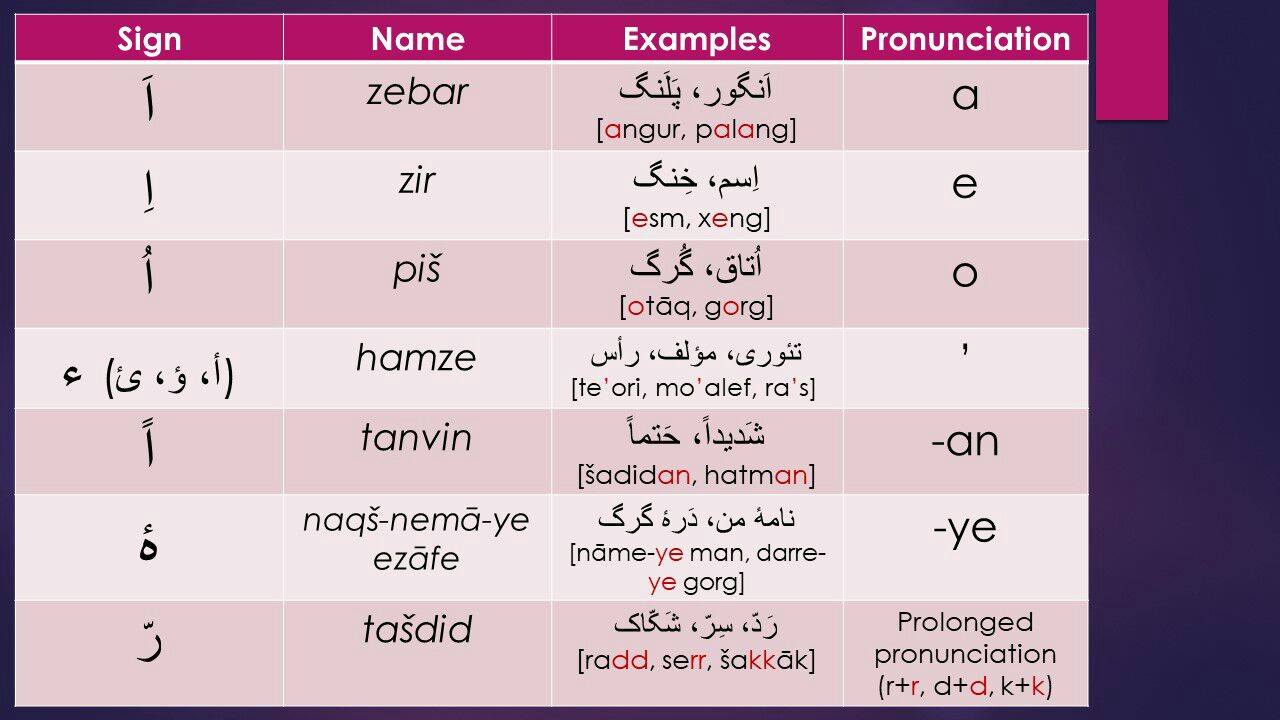
اُ , اِ , اَ (zebar, zir and piš) - these signs represent the unwritten short vowels (a, e, o) that I mentioned above. If the short vowel is pronounced in the beginning of the word, the sign is put over the letter alef (like in the examples you see here). In the middle of the word they are put over the letter after which the sound comes.
You will not find these signs very often in the texts intended for the average Persian reader, like newspapers, novels, etc. However, they are generally utilized in texts intended for beginner-level students.
ء (hamze), ؤ، ئ، أ - The hamze represents the glottal stop (original to Arabic) in the Persian alphabet. Currently, it is used to indicate the transitional pause when two vowels happen to be situated side by side (almost like Greek diaeresis).
For instance, we know that the مؤلف is pronounced mo’alef, or the word تئوری is pronounced te’ori thanks to this sign (which is indicated here by the apostrophe). Otherwise we would be inclined to read those words mulef or tivori, respectively. As a rule, the hamze is used in words of Arabic or European origin.
اً (tanvin) - is a simple sign found at the end of some words and is pronounced -an. It indicates that the word in question is in an adverbial form. For instance, the word شدید means “strong, intense, grave”. When we add the sign اً (-an) at the end, we get شدیداً which means “strongly, intensely, gravely”. However, keep in mind that this is generally used for words of Arabic origin.
ۀ (naqš-nemā-ye ezāfe) - This sign, as you can see, is somewhat like the hamze sign discussed above. But they function differently and are used in different positions. Naqš-nemā-ye ezāfe is always found at the end of a word and is put over the letter ه as you see in the example. It is pronounced -ye and indicates the ezāfe construction in Persian. In contrast to the hamze sign, it is a supplement for the letter ی (y), which is sometimes used instead of naqš-nemā-ye ezāfe to indicate the ezāfe construction.
When did Iranians start using the Arabic script?
After the rise of Islam and the conquest of Iran by the Arabs, Iran fell under the heavy influence of the Islamic/Arabic culture. This is not to say that Iran contributed nothing to the Islamic civilization, on the contrary, many basal features of the Islamic culture as we know it today, were developed under the influence of the Iranian culture.
However, this was not the case with the alphabet. The acceptance of Islam by the majority of the population of Iran brought also some changes in the literary tradition of the Iranians.
If you are well familiar with the history of religions, then you may have noticed the tendency of the followers of different religions to associate the script of their holy scriptures with their religion. Thus, the Arabic script is keenly associated with the Islamic religion, while, for instance, the Arab-speaking Syriac Christians used to write their Arabic in the Syriac “Christian” alphabet.
This tendency caused the newly converted Iranians to start using the Arabic script for their local languages, among them Persian. This change was more than welcome, for the previous script used to write Persian (the Pahlavi script), was extremely hard to use (we may call it “user-hostile”).
Thus, gradually, the Arabic script began to be widely and officially used for writing the Persian language.
Farsi alphabet and the 20th century.
Today, among the three Persian-speaking nations (Iran, Afghanistan, and Tajikistan) only the first two continue using the Arabic script, while Tajikistan has changed its alphabet to Cyrillic (Russian is written in Cyrillic).
Other nations too, like Turkey, have shifted their scripts from Arabic into Latin. This has been done to escape the difficulties that the Arabic script presents (like not writing of the short vowels).
Unsurprisingly, this question has also been discussed for decades in Iran too. The question of alphabet reform was on the table since the half of the 19th century. Intellectuals, like Mirza Fath Ali Akhundzadeh or Mirza Malkom Khan, were considering the difficult Arabic alphabet as the main reason for the technological and cultural backwardness of the ‘Islamic nations’. To remedy the situation, they proposed changing or reforming the alphabet, which would considerably facilitate the spread of literacy among the population.
The topic of the alphabet reforms continued to cause heated debates among the Iranian intellectuals for decades after Akhundzadeh and Malkom Khan. However, unlike Turkey, which didn’t risk losing much after severing its ties with its literary past, the Iranians were under the imminent danger of facing a literary catastrophe after drastic alphabet reforms.
The rich literary heritage, accumulated over a thousand years, was probably the main factor that kept such a change from happening.
The scripts used for Persian before Islam.
If you have read my previous article about the Persian language, you already know that Persian has a long (2500-year long) history. We divide that period into three phases: Old Persian, Middle Persian and New Persian.
Now, the Arabic script has only been used for writing the New Persian language. However, before the rise of Islam and the adaptation of the Arabic script, Persians had other scripts and left many literary monuments in these scripts.
The Old Persian script
The Old Persian script is a cuneiform script. The word cuneiform in English comes from Latin cunei, which simply means wedge. It is called that way because its characters consist of different wedge-shaped figures.
It was probably first introduced during the reign of Darius the Great, one of the most important Achaemenid kings (who is also mentioned in the Bible). The most significant and long inscription in this script, which was adapted from the older Mesopotamian cuneiform scripts, is the inscription at the Mt. Behistun, near the city of Kermanshah (in Iran).
The Old Persian script is written from left to right, like the Latin script. Each sign represents either a sound or two sounds (consonant + vowel). There are overall 38 characters representing various sounds or combinations, less than a dozen ideograms, and numerical signs.
The basic principle is this: there are separate signs for the vowels and consonants. Then the combination of almost every consonant and vowel is represented by a different sign.
The Middle Persian scripts
Middle Persian was the official language of the Sasanian Empire. It was also the second important language of the Zoroastrian religion.
However, it was not written in a single alphabet. We have two groups of alphabets in which Middle Persian is written.
The first, and most characteristic one is called Pahlavi script. This is the script by which the Zoroastrians used to write their literature. It has three varieties which are called: Inscription Pahlavi alphabet, Book Pahlavi alphabet, and Pahlavi Psalter alphabet.
The Inscription Pahlavi alphabet, which as you can guess is found in the inscriptions dating to the Sasanian period (224 - 651 AD), has overall 22 letters. It is based upon the Arameic alphabet.
This script is written from right to left. Most of its letters, as is characteristic to the Semitic alphabets, represent the consonants. A couple of letters are found only in words of Arameic origin.
The Book Pahlavi alphabet is a later development of the Inscription Pahlavi. Despite the word ‘development’, it doesn’t represent any improvement on the previous version. On the contrary, the number of letters has been reduced to 14, and difficulties in writing the script are sometimes overwhelming. There are signs that may represent 4 or 5 sounds at the same time. You can only rely upon your memory or the context to determine how to read the word.
Add to that also the fact that this alphabet is also a cursive one, i.e. the letters tend to be combined in the lines. Sometimes this may result in different configurations that you have to learn by heart.
This script was in use when the Arabic alphabet began to be adopted. Now you can understand, what an improvement was the Arabic script in comparison to this.
The Psalter Pahlavi script was found on a small manuscript fragment and represents a middle stage between the Inscription and Book Pahlavi scripts.
Besides these, there was also another alphabet, by which the Middle Persian language was written. This was the Syriac alphabet, which was adopted by the followers of Mani, the founder of the Manichaean religion.
Learn the Persian alphabet!
If you are interested in learning Persian, you have to try to learn the Persian alphabet. In learning the language this is an unavoidable condition. If you are a language geek, then you are most probably going to enjoy this process.
You may wonder why I am emphasizing this part especially? The reason is simple, most of the Persian courses that are out there on the Web (especially apps) don't pay proper attention to the learning of the Persian alphabet, or touch it very briefly.
This is a regrettable reality, for students who are not familiar with the eastern-type alphabets will puzzle themselves over it a lot.
So my advice to all you beginners. If the online course you have chosen does not offer enough instruction in the Persian alphabet, or you are facing difficulties in understanding its basic principles, you might have a couple of options. If this is the case:
Try to find other courses that offer a better explanation. Learn the alphabet and then come back to your original course.
Try to find a textbook of Persian, and learn the alphabet from there. You may also try to find an article on the Web.
And finally, you are always welcome to sneak into an Arabic course, learn the alphabet from there, and then come back to your Persian course. When you come back, don’t forget to repeat the Persian alphabet in order to master the very slight differences that exist between the Arabic and Persian alphabets.
Learn Farsi
As soon as you learn the Persian alphabet apply to Persian language courses of ASPIRANTUM and learn Persian in Armenia.

